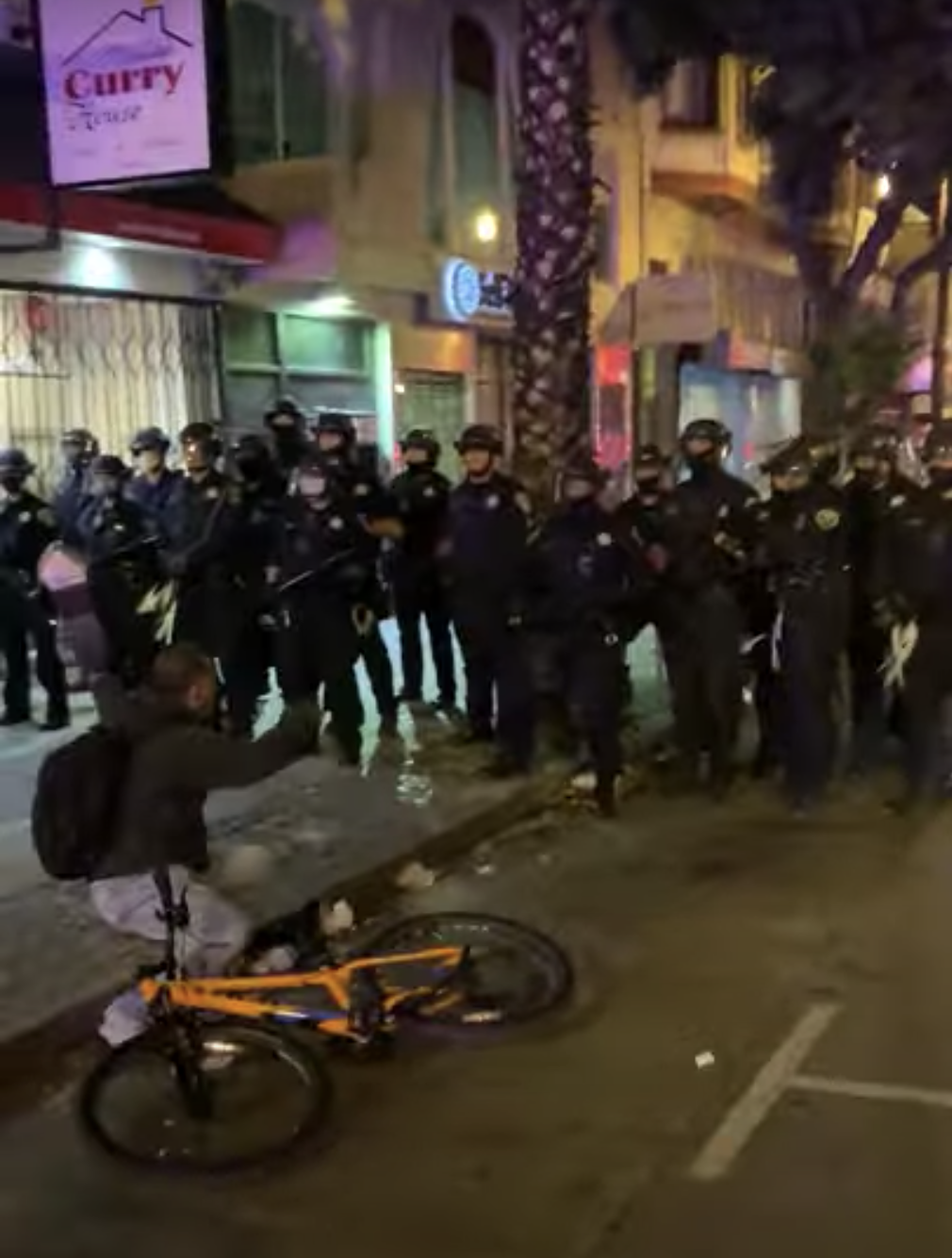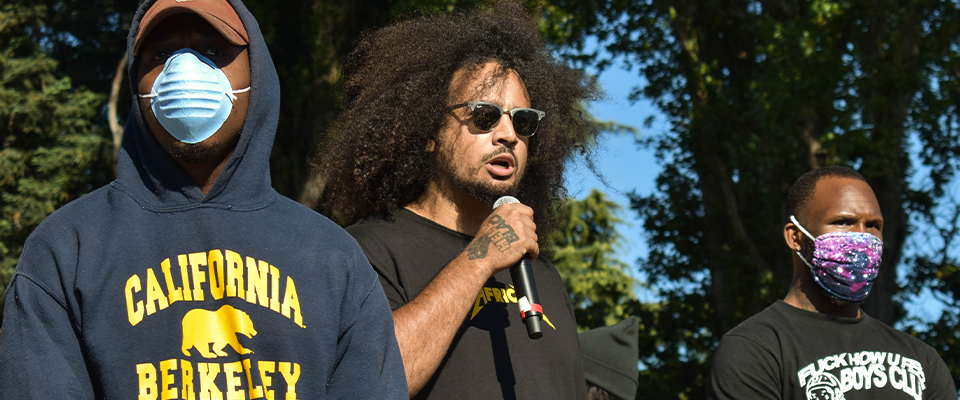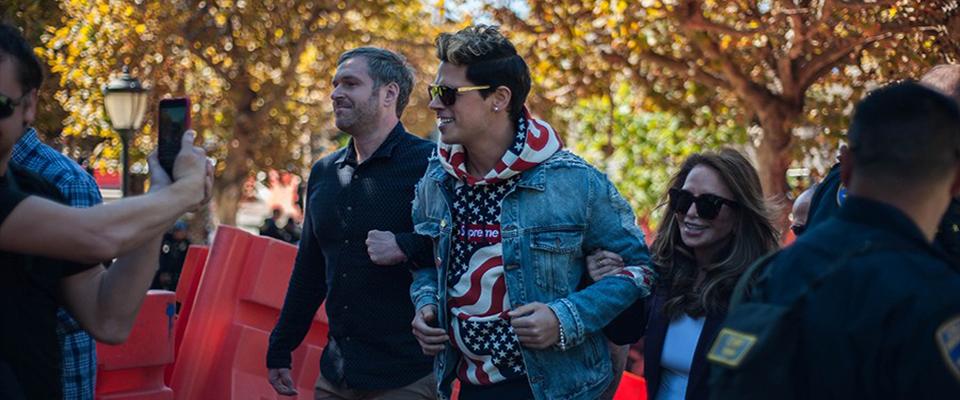Ray Durham, a law student at UC Berkeley, had a decision to make: break the law and risk his life, or abandon a protest about proving that it matters.
On June 1, amid unprecedented Black Lives Matter demonstrations in the Bay Area following George Floyd’s murder by Minneapolis police, Alameda County announced an 8 p.m. curfew. The curfew was announced as the 15,000-person protest Durham attended was well under way. Officers later fired tear gas to disperse the demonstration before the curfew even began.
“I’m willing to put my safety on the line for that, even though I know Black people are disproportionately affected by these police tactics.”—Ray Durham
After fleeing from the gas, Durham, who is Black, sat with friends outside a nearby BART station, discussing whether they should keep protesting. As they deliberated, a demonstrator in a gas mask and gloves walked over and handed them a container of a chemical solution labelled, “Use in case of tear gas.”
“It was like, oh, these people are prepared, they are ready, and they also have our back,” he says. “That pushed me to be more impassioned. I was pissed off about the curfew. The protests so far had been very peaceful.”
Before the week was over, Alameda, Contra Costa, San Mateo, and Napa counties had curfews, as did the cities of Palo Alto and San Francisco, affecting a cumulative 5.5 million people. Across the U.S., an estimated 60 million people were on temporary lockdown. While supporters defended the measures as necessary to stop looting and protect public safety, critics pointed to the long history of using curfews to stifle civil rights and, particularly, movements for Black lives.
In the Bay Area, curfews faced immediate resistance. Thousands continued protesting past the curfews, including a sit-in at the San Francisco Hall of Justice. “Fuck the curfew” became a popular chant. For Durham, the seemingly disproportionate response of the police to the protests helped inspire him to stay.
“I’m willing to put my safety on the line for that, even though I know Black people are disproportionately affected by these police tactics,” he says. “It was so worth it to be defiant in the face of something that was so obviously undemocratic and fascist, for lack of a better term. It was very obvious that it was state controlled militarization of these forces that were trying to quiet the voice of the people.”
Kynchelle Passmore, another Berkeley Law student, who is also Black, was at the protests in Oakland when the curfew was announced and decided to stay out anyway—at least at first.

“I felt safe during the protest. If the protests would’ve continued past 8 o’clock without the police presence, we all would’ve continued to keep ourselves safe,” Passmore says. “That was one of the chants actually: ‘Who keeps us safe? We keep us safe.’ I’m 24. I’ve never felt safe around the police.”
She was right near the front when police started firing tear gas, and the experience made her worry she wouldn’t be able to outrun another barrage of chemical weapons.
“I didn’t want to slow down my friends. I didn’t want to be the person they had to go back for,” she says. The following nights she stayed home, on-call to help friends who were out protesting.
While the curfew was ostensibly enacted to “protect public health and safety,” the majority of curfew-related arrests in Oakland and San Francisco appeared to be for protesting, not looting. On the night the curfew went into effect in Oakland, of the 100 people arrested, 80 were for curfew violations, unlawful assembly, or failure to disperse. (Oakland police did not provide more detailed data before this story was published.) In San Francisco, police report that between May 31 and June 7, out of a total 263 protest-related arrests, more than half were for curfew violations. The picture was similar across the country, where protests occurred in all 50 states. In the week and a half following Floyd’s death, which saw the most dynamic, well-attended phase of protesting so far, over 10,000 people were arrested at demonstrations, according to an analysis from the Associated Press, but looting and burglary arrests only numbered in the hundreds.
It wasn’t only protestors but also journalists who found themselves entangled with local law enforcement. Julian Mark, a reporter for Mission Local, had gone back to the office late on Wednesday, June 3 to finish a story. Outside his window in the Mission District of San Francisco, dozens of riot police surrounded a group of 23 young protestors. He went down to observe and was detained alongside them for violating the city’s curfew.
“As soon as I showed my press badge, there was no reasonable suspicion on the officers’ part for holding me,” he said. Though he was legally credentialed by the SFPD, it took a call from his editor to the captain overseeing the scene for him to be released. “They knew that I was covering this, that I was a journalist, and they had no grounds to hold me, and yet they did so for 30 to 40 minutes.”

Christopher Petrella, a doctoral graduate of African Diaspora Studies at Berkeley explained that curfews have a nefarious history. As he recently wrote in the Washington Post, “Although justified by officials as a tool to promote public safety, historically, curfews have been most frequently used to suppress insurgent political challenges, particularly those aimed at opposing white supremacy.”
The first curfews targeting Black people are older than the U.S. itself, dating back to slave laws in the Thirteen Colonies. Since then they have been used to quell nearly every mass civil rights protest from the 1919 Red Summer and the 1943 Harlem Riots to the Rodney King Riots and more recently the Ferguson protests.
The irony of curfews, of course, is that in the context of a movement protesting police overreach, they often end up doing the opposite of what they intend by galvanizing demonstrators.
“There is such high interest in showing up for racial justice right now in the streets that police agencies know that they cannot control us with their quote, unquote crowd control measures,” says Amalya Dubrovsky, a student at the Berkeley School of Journalism, who has been attending the protests. “They had to let the peaceful protests continue. There’s no way they could arrest all of us.”
In the Bay Area, curfew critics eventually won out. On June 3, the Northern California American Civil Liberties Union (ACLU) chapter sent letters to various Bay Area authorities, calling curfews “a signature measure of a police state” because they limited free assembly, speech, and press rights. By June 4, San Francisco, Oakland, and much of the Bay Area lifted their shutdown orders.
For Durham, continuing to engage in the protests, curfew or otherwise, is a reminder of why he’s at Berkeley in the first place: to use the law to fight for justice. He’s considering a career as a court-appointed public defender.
“The criminal justice system is just messed up and extremely problematic and disproportionately affects people from my community, and it’s not just anecdotal,” he says. “It’s something that people who aren’t just interested in criminal justice are now realizing throughout the U.S.”




















